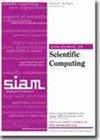Sparse Recovery of Elliptic Solvers from Matrix-Vector Products
IF 2.6
2区 数学
Q1 MATHEMATICS, APPLIED
引用次数: 0
Abstract
SIAM Journal on Scientific Computing, Volume 46, Issue 2, Page A998-A1025, April 2024.Abstract. In this work, we show that solvers of elliptic boundary value problems in [math] dimensions can be approximated to accuracy [math] from only [math] matrix-vector products with carefully chosen vectors (right-hand sides). The solver is only accessed as a black box, and the underlying operator may be unknown and of an arbitrarily high order. Our algorithm (1) has complexity [math] and represents the solution operator as a sparse Cholesky factorization with [math] nonzero entries, (2) allows for embarrassingly parallel evaluation of the solution operator and the computation of its log-determinant, (3) allows for [math] complexity computation of individual entries of the matrix representation of the solver that, in turn, enables its recompression to an [math] complexity representation. As a byproduct, our compression scheme produces a homogenized solution operator with near-optimal approximation accuracy. By polynomial approximation, we can also approximate the continuous Green’s function (in operator and Hilbert–Schmidt norm) to accuracy [math] from [math] solutions of the PDE. We include rigorous proofs of these results. To the best of our knowledge, our algorithm achieves the best known trade-off between accuracy [math] and the number of required matrix-vector products. Reproducibility of computational results. This paper has been awarded the “SIAM Reproducibility Badge: Code and data available” as a recognition that the authors have followed reproducibility principles valued by SISC and the scientific computing community. Code and data that allow readers to reproduce the results in this paper are available at https://github.com/f-t-s/sparse_recovery_of_elliptic_solution_operators_from_matrix-vector_products and in the supplementary materials (CompressingSolvers.jl-main.zip [2.50MB], sparse_recovery_of_elliptic_solution_operators_from_matrix-vector_products-main.zip [54.8KB]).
从矩阵矢量乘积稀疏恢复椭圆求解器
SIAM 科学计算期刊》,第 46 卷第 2 期,第 A998-A1025 页,2024 年 4 月。 摘要。在这项工作中,我们证明了[math]维的椭圆边界值问题的求解器可以仅通过[math]矩阵与精心选择的向量(右手边)的[math]矩阵向量积来近似[math]精度。求解器只能作为黑盒子访问,底层算子可能是未知的,而且是任意高阶的。我们的算法(1)具有[数学]复杂度,并将求解算子表示为具有[数学]非零项的稀疏 Cholesky 因式分解;(2)允许对求解算子进行令人尴尬的并行评估,并计算其对数决定式;(3)允许对求解器矩阵表示的各个项进行[数学]复杂度计算,进而将其重新压缩为[数学]复杂度表示。作为副产品,我们的压缩方案产生了近乎最佳近似精度的同质化求解算子。通过多项式逼近,我们还能从 PDE 的 [math] 解中逼近连续格林函数(在算子和希尔伯特-施密特规范中),逼近精度达到 [math]。我们对这些结果进行了严格的证明。据我们所知,我们的算法在精度[math]和所需矩阵矢量乘积数量之间实现了已知的最佳权衡。计算结果的可重复性。本文被授予 "SIAM 可重复性徽章":代码和数据可用",以表彰作者遵循了 SISC 和科学计算界重视的可重现性原则。读者可以在 https://github.com/f-t-s/sparse_recovery_of_elliptic_solution_operators_from_matrix-vector_products 和补充材料(CompressingSolvers.jl-main.zip [2.50MB], sparse_recovery_of_elliptic_solution_operators_from_matrix-vector_products-main.zip [54.8KB])中获得代码和数据,以重现本文的结果。
本文章由计算机程序翻译,如有差异,请以英文原文为准。
求助全文
约1分钟内获得全文
求助全文
来源期刊
CiteScore
5.50
自引率
3.20%
发文量
209
审稿时长
1 months
期刊介绍:
The purpose of SIAM Journal on Scientific Computing (SISC) is to advance computational methods for solving scientific and engineering problems.
SISC papers are classified into three categories:
1. Methods and Algorithms for Scientific Computing: Papers in this category may include theoretical analysis, provided that the relevance to applications in science and engineering is demonstrated. They should contain meaningful computational results and theoretical results or strong heuristics supporting the performance of new algorithms.
2. Computational Methods in Science and Engineering: Papers in this section will typically describe novel methodologies for solving a specific problem in computational science or engineering. They should contain enough information about the application to orient other computational scientists but should omit details of interest mainly to the applications specialist.
3. Software and High-Performance Computing: Papers in this category should concern the novel design and development of computational methods and high-quality software, parallel algorithms, high-performance computing issues, new architectures, data analysis, or visualization. The primary focus should be on computational methods that have potentially large impact for an important class of scientific or engineering problems.

 求助内容:
求助内容: 应助结果提醒方式:
应助结果提醒方式:


